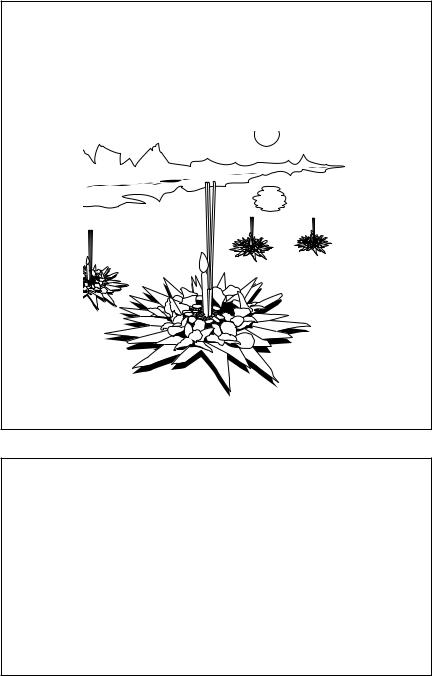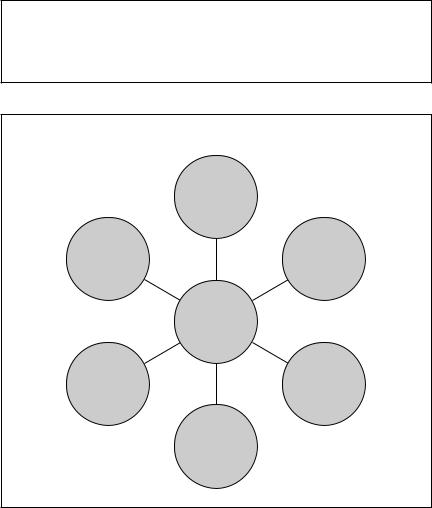

4The world around us
4.1Rivers of the world
Level |
|
* |
Language focus |
|
Vocabulary: names of rivers, letters of the alphabet |
Skills focus |
|
Listening for details |
Thinking focus |
|
Recognising and writing letters |
Teaching approach |
|
Promote accuracy – correct errors |
Interaction |
|
Whole class work, suitable for large classes |
|
|
|
Procedure
1Explain to the class that you are going to read out the names of some famous rivers in the world.
2Tell the children that you will spell out the name of each river, and as you say the letters, you want them to write the name of the river. You will say each letter once, so they have to listen carefully the first time. Make sure they know to begin each word with a capital letter.
3Choose one river from Box 69 and say the name of the river first. Then carefully spell out the word, allowing time for the children to write it. When spelling out Mississippi, you should say double s and double p.
4When you have spelled out all the names of rivers from Box 69, choose children to write the correct spelling on the board for the others to check their answers.
Box 69 World rivers
A–M–A–Z–O–N |
South America |
N–I–L–E |
Africa |
D–A–N–U–B–E |
Germany/Europe |
G–A–N–G–E–S |
India/Asia |
M–I–S–S–I–S–S–I–P–P–I |
The United States |
S–E–I–N–E |
France/Europe |
Y–A–N–G–T–S–E |
China/Asia |
|
|
78

The world around us
Follow-up
•Ask the children to sort the rivers into alphabetical order.
•Ask the children to use an atlas to find these rivers. Then ask them to note the country or continent through which the rivers flow. They could also discover which river is the longest and which is the shortest.
4.2 Map making
|
|
|
Level |
* |
|
Language focus |
Map, geography words, letters of the alphabet, numbers |
|
Skills focus |
Listening for details |
|
Thinking focus |
Labelling |
|
Teaching approach |
Promote accuracy – correct errors |
|
Interaction |
Pairwork, suitable for large classes |
|
Preparation |
Draw a map-making grid on the board. See Box 70. |
|
|
|
|
Procedure
1Divide the class into pairs and ask each pair to copy the map-making grid from the board. See Box 70. You may want to introduce new vocabulary from Box 71 before you begin the activity.
2Tell the class that they are going to draw a map and they have to listen for two pieces of information.
3One person in the pair has to listen for the coordinate, which will be a combination of one letter and one number, e.g. C3. The other person has to listen for the geographical feature, e.g. A big blue lake.
4Together, they combine their information and draw the geographical feature on their map-making grid.
Box 70 Map-making grid
4 |
|
|
|
|
3 |
|
|
|
|
2 |
|
|
|
|
1 |
|
|
|
|
A |
B |
C |
D |
E |
79

Five-Minute Activities for Young Learners
Box 71 Map-making instructions
At C3 draw a big blue lake.
At A1 draw a small green mountain.
At E1 draw a big brown mountain.
At B3 draw a long beach.
At B4 draw a blue sea.
A river flows from E1 to C3.
Follow-up
•Ask the pairs to prepare their own map. They take turns to give mapmaking instructions to their partner, who draws their map on a mapmaking grid. When they have finished, they compare maps and check that their partner has followed their directions.
•If you want to practise other numbers or letters, change the coordinates. For example, you may want to have numbers from 6 to 10, and letters from L to P.
4.3 Drawing my natural world
Level |
|
* |
Language focus |
|
Prepositions of place, present continuous tense |
Skills focus |
|
Reading and speaking |
Thinking focus |
|
Illustrating and interpreting |
Teaching approach |
|
Promote accuracy – correct errors |
Interaction |
|
Whole class work, suitable for large classes |
Preparation |
|
Write the sentences from Box 72 onto separate pieces of |
|
|
paper. |
|
|
|
Procedure
1Divide the class into groups with three children in each group.
2Ask one child from each group to come to the front of the class, and show them a sentence from Box 72. Each child should see the same sentence clue.
3They return to their groups and, without speaking, draw the information you have shown them.
4The first group to guess the answer and correctly say the sentence wins a point.
80

The world around us
5Then the next person in each group has a chance to read one of your sentences and draw the information for their group.
6Continue until all group members have had a chance to participate.
Box 72 Having fun in nature: sentences
1He/She is flying over a mountain.
2He/She is jumping in a river.
3He/She is riding around an island on a bike.
4He/She is running on a beach.
5He/She is swimming under the sea.
6He/She is swimming across a lake.
7He/She is walking behind a waterfall.
8He/She is sitting on a mountain.
4.4 North, south, east and west
|
|
|
Level |
* |
|
Language focus |
Chant, vocabulary: names of cities and countries |
|
Skills focus |
Speaking: stress patterns |
|
Thinking focus |
Inventing |
|
Teaching approach |
Promote accuracy – correct errors |
|
Interaction |
Whole class work, suitable for large classes |
|
|
|
|
Procedure
1Point to the north and ask the children to copy you and say North.
2Now point to the south, the east and then the west, and each time ask the children to point and say the word.
3Together, chant North, south, east and west in a singsong style, taking care to stress all words except and. Each time the children say a direction, get them to point in that direction.
4Next, ask the children to name a favourite place in the world. It could be their own town or country, or it could be a place they would like to visit.
5Write the place on the board and make a note of the number of syllables it has and where the stress falls. See Box 73 for some examples.
6Add this place to the chant. The children will now say something like
North, south, east and west, Spain is the place that I like best. Ask the children to point in the direction of north, south, east and west for the
81

Five-Minute Activities for Young Learners
first part of the chant, and clap on the stressed syllables in the second part of the chant. The stressed syllables are in bold.
7 Continue to add new places to the chant.
Box 73 Chanting about places
Chant |
Places with |
Places with |
Places with |
|
stress on the |
stress on the |
single syllable |
|
first syllable |
second syllable |
|
|
|
|
|
North, south, |
China |
Brazil |
France |
east and west, |
Paris |
Berlin |
Rome |
. . . is the place |
Sweden |
Dubai |
Greece |
that I like best. |
London |
New York |
Spain |
|
|
|
|
Follow-up
•Vary the chant from the first person to the third person, making sure the children pronounce the third person s sound and continue to note the stressed syllables.
•The children use their atlases to find the places in their chant.
•For other chants and raps, see Activities 1.11, 2.7, 4.6, 5.1, 5.7, 6.1.
4.5 Geographical tongue twisters
Level |
|
* |
Language focus |
|
Word order in a simple sentence |
Skills focus |
|
Pronunciation: initial consonants |
Thinking focus |
|
Constructing |
Teaching approach |
|
Promote accuracy – correct errors |
Interaction |
|
Team work, suitable for large classes |
|
|
|
Procedure
1Divide the class into two teams.
2On the board, write the verb is bouncing and the geographical place beach.
3Team 1 suggests a subject for the verb is bouncing, e.g. A ball. The aim of the competition is to suggest words starting with b.
4Team 2 suggests another word to add to the sentence. The sentence could now read A big ball is bouncing . . . beach.
82

The world around us
5The first team may want to change the sentence to make A big ball the object. In this way, they could add another b word as a subject, e.g. Ben is bouncing a big ball . . . beach.
6Each team continues to add a b word to the sentence. The last team to add a word is the winner. See Box 74 for some sentence ideas.
7It is important to pay attention to the grammatical accuracy of the children’s suggestions and make corrections where necessary.
8Finally, the class reads the tongue twister aloud.
Box 74 Sample tongue twisters
BBen’s brother is bouncing a big ball on a blue and black boat beside a beautiful beach.
W A woman is walking and watching a wonderful waterfall.
FFive fathers and their friends are fishing for their favourite fish in the forest.
S |
Sad Sam’s sister Sue and six small snakes are swimming in the sea. |
Follow-up
•Choose other letters of the alphabet and ask pairs to create new tongue twisters. Each time, write the verb and the geographical place. Each team has a turn to add a new word to make a sentence. See Box 74.
•Display the tongue twisters in the classroom and regularly ask the children to say them aloud. Alternatively, you could create a class book of tongue twisters.
4.6 Sphere shapes
|
|
|
Level |
* |
|
Language focus |
Chant, vocabulary: spherical objects |
|
Skills focus |
Speaking |
|
Thinking focus |
Recalling and sequencing |
|
Teaching approach |
Promote creativity – accept errors |
|
Interaction |
Small group work, suitable for large classes |
|
Preparation |
For this activity, you will need to bring a spherical object, e.g. |
|
|
a ball, to class. |
|
|
|
|
83

Five-Minute Activities for Young Learners
Procedure
1Hold up the ball and tell the class that it is the shape of a sphere. Write the word Sphere on the board. Say the word Sphere and ask the class to say the word after you.
2Tell them that our world is also a sphere.
3In small groups, get the children to write any other objects they know of that are in the shape of a sphere.
4Ask the groups to share their answers and write the words on the board. See Box 75 for some suggestions.
5Then ask the groups to sequence the spheres from the largest to the smallest.
Box 75 Sphere words
apple, onion, orange, pea, potato, tomato, tennis ball, basket ball, table-tennis ball, eye, head, sun, moon
Follow-up
•Teach the children the chant about spheres. See Box 76. The stressed syllables are in bold. Ask the children to stamp their feet on the stressed syllables, and spin around on the words spin, spin, spin. For the last line, they clap and stamp on the stressed syllables.
•You could adapt this activity by asking the children to find examples of other shapes, like cubes, cylinders, squares or circles.
•For other chants and raps, see Activities 1.11, 2.7, 4.4, 5.1, 5.7, 6.1.
Box 76 Sphere chant
Apples and onions,
The moon and the sun.
These are spheres – every one.
The world is a sphere – spin, spin, spin.
The world is the sphere that we live in!
84

|
|
The world around us |
4.7 New Year celebrations |
||
|
|
|
Level |
** |
|
Language focus |
Vocabulary: size, colour, adjectives, nouns, names of |
|
|
countries |
|
Skills focus |
Listening for details |
|
Thinking focus |
Sorting |
|
Teaching approach |
Promote accuracy – correct errors |
|
Interaction |
Group work |
|
Preparation |
Photocopy the listening grids for the children to complete. |
|
|
Their copies should contain only the headings in the shaded |
|
|
areas of the grid. See Box 77. |
|
|
|
|
Procedure
1Tell the class that people all over the world celebrate the New Year in different ways. If you have time, ask them to tell you briefly how they celebrate the New Year.
2Divide the class into teams with four children in each team. Allocate one of the headings to each member of the team: size, colour, other adjective and noun. See Box 77.
3Tell the children that each person in the team has to listen for different key words.
4Read out the sentences from Box 78, allowing enough time for each member to write down their key word and complete the listening grid.
Note: In this activity, check that the less able learners listen for vocabulary like size or colour, and the more advanced learners listen for the other adjective or the noun.
Box 77 |
Listening grid |
|
|
|
|
|
|
|
|
|
|
Size |
|
Colour |
Other |
Noun |
Place |
|
|
|
adjective |
|
|
|
|
|
|
|
|
small |
|
red |
square |
envelopes |
China |
big |
|
white |
round |
rice cakes |
Korea |
small |
|
brown |
sweet |
doughnuts |
Holland |
very small |
|
yellow and black |
soft |
peas |
United States |
small |
|
green |
tasty |
12 grapes |
Spain |
long |
|
yellow |
thin |
noodles |
Japan |
|
|
|
|
|
|
© Cambridge University Press 2007
85

Five-Minute Activities for Young Learners
Box 78 International New Year celebrations
1In Spain we eat 12 small, tasty, green grapes on New Year’s Eve.
2People in the south of the United States eat very small, yellow and black, soft peas to bring them good luck in the New Year.
3Every Chinese New Year, our parents give us a small, red, square envelope with money inside it.
4On New Year’s Eve in Japan, people eat long, thin, yellow noodles.
5Korean people eat big, white, round rice cakes on New Year’s Day.
6In Holland we enjoy eating small, brown, sweet doughnuts to celebrate the New Year.
4.8 New Year’s Day emails
Level |
|
** |
Language focus |
|
Email, simple present tense |
Skills focus |
|
Reading and writing |
Thinking focus |
|
Producing and inventing |
Teaching approach |
|
Promote creativity – accept errors |
Interaction |
|
Individual work, suitable for large classes |
Preparation |
|
Photocopy or make an overhead transparency of the text. See |
|
|
Box 79. |
|
|
|
Procedure
1Tell the class that a pen pal from Australia has written to them, asking them about how they celebrate the New Year. Show them the text from Box 79.
2Ask them to write a brief reply. Useful sentence stems from the email are in bold. Encourage the children to use these sentence stems in their reply email.
Note: If you prefer, you could jointly construct a class email reply. In this case, you ask the children to make suggestions and you write these on the board. Then, together, you make corrections and think about ways to improve the email.
86

The world around us
Box 79 Email from Australia
Hi
We are the children in Year 5 at Sunshine Beach Primary School. Every New Year, hundreds of people come to our beach to celebrate the New Year. We usually have a party on New Year’s Eve and all the kids can stay awake until midnight. The next day, everyone is very tired.
How do you celebrate the New Year?
© Cambridge University Press 2007
Follow-up
For other cards, letters and emails, see Activities 2.12, 5.11, 5.15, 6.8.
4.9 Loy Krathong Festival from Thailand
|
|
|
Level |
** |
|
Language focus |
Description, simple present tense |
|
Skills focus |
Note taking |
|
Thinking focus |
Differentiating |
|
Teaching approach |
Promote accuracy – correct errors |
|
Interaction |
Pairwork, suitable for large classes |
|
Preparation |
Photocopy the brief description of the Loy Krathong Festival. |
|
|
See Box 80. Draw the note-taking grid on the board and write |
|
|
in the questions. See Box 81. |
|
|
|
|
Procedure
1Give each pair the short description of the Loy Krathong Festival from
Thailand. See Box 80. If you have a world map, show the children where Thailand is.
2Ask the children to complete the note-taking grid. This will encourage them to read for specific details, as opposed to copying whole sentences. It is also important to emphasise that you do not expect them to recognise every word, but to make inferences about the meanings of words from the context of the paragraph.
3When the children have finished, complete the note-taking grid on the board.
87

Five-Minute Activities for Young Learners
Box 80 Loy Krathong Festival
The Loy Krathong Festival is a famous festival in Thailand. It happens during the full moon in the twelfth month. The Thai people make a Krathong boat from banana leaves. They put candles, flowers and money into the boat. In the moonlight, they put their Krathongs into the river and hope that all their bad luck will float away.
© Cambridge University Press 2007
Box 81 Loy Krathong: note-taking grid
Question |
Notes |
||
|
|
|
|
1 |
Where is the festival? (Two words) |
1 |
Thailand, river |
2 |
When is the festival? (Two words + two |
2 |
Full moon, twelfth month |
|
words) |
|
|
3 |
Why do they have the festival? (Five |
3 |
Bad luck will float away |
|
words) |
|
|
4 |
What is a Krathong? (One word) |
4 |
Boat |
5 |
What is a Krathong made of? (Two words) |
5 |
Banana leaves |
6 |
What is in the Krathong? (Three words) |
6 |
Candles, flowers, money |
|
|
|
|
88

The world around us
Follow-up
•Ask each pair, from their notes, to write their own description of the Loy Krathong Festival.
•Children who are particularly interested in international festivals may like to conduct further research into this famous Thai festival.
•Get the children to make their own Krathongs and have a Loy Krathong Festival beside a river or pool of water.
4.10 Pinocchio: an Italian story
|
|
|
Level |
** |
|
Language focus |
Narrative, comparatives and superlatives |
|
Skills focus |
Pronunciation: word stress |
|
Thinking focus |
Recalling |
|
Teaching approach |
Promote accuracy – correct errors |
|
Interaction |
Whole class work, suitable for large classes |
|
Preparation |
On the board, write the children’s part of the story telling. See |
|
|
Box 82. |
|
|
|
|
Procedure
1Divide the class into three groups. Explain that you are going to tell them a very old story from Italy, and that you want them to join in. You may want to explain vocabulary such as puppet and lie before you start to tell the story.
2With dramatic expression, begin to tell the story of Pinocchio.
3When you get to the part when the children join in, point to Group 1 and then to their lines on the board. Encourage the children to use gestures to show how the nose becomes longer each time.
4Point to Group 2 to join in the chant, and then to Group 3. Each time the volume of the story increases as another group joins in the chant.
5Finally, the whole class joins in the last part of the story.
89

Five-Minute Activities for Young Learners
Box 82 Pinocchio story telling
Participants |
Story |
|
|
Teacher |
Once upon a time, an old man called Geppetto made a |
|
puppet from a piece of wood. Then one day, the puppet |
|
started to walk and talk. His name was Pinocchio. One |
|
day, Pinocchio told his father a lie. His nose started to |
|
grow. |
Children: Group 1 |
He told another lie and his nose grew longer. |
Children: Groups |
He told another lie and his nose grew longer and longer. |
1 and 2 |
|
Children: Groups 1, |
He told another lie and his nose grew longer and longer |
2 and 3 |
and longer. |
Children: Together |
Soon he had the longest nose in the village. |
|
|
Follow-up
•Check your library for the complete story of Pinocchio. Try to find an illustrated version of the story and read it to the class.
•For other narratives, see Activities 2.16, 3.5, 3.13, 3.14, 3.18, 5.1, 6.18.
4.11 Carnival in Brazil
Level |
|
** |
Language focus |
|
Description, simple present tense |
Skills focus |
|
Listening for key words |
Thinking focus |
|
Identifying and selecting |
Teaching approach |
|
Promote creativity – accept errors |
Interaction |
|
Group work, suitable for large classes |
|
|
|
Procedure
1Remind the class of the steps in a dictogloss. See Activity 2.15 for detailed instructions.
2Ask them to recall carnivals or festivals in their own country.
3Read out the description of a carnival in Brazil at a slow and steady pace.
See Box 83. Remember, the pace must be a little faster than a dictation.
4While you are reading, the children are writing key words from the text.
90

The world around us
5When you have finished reading, ask small groups of children to reconstruct the original text.
6At the end of the activity, the children compare their descriptions with the original text.
Box 83 Description of a Brazilian carnival
Every year, people in Brazil have a big party. It goes on for four days and four nights. They have a lot of loud music and dancing and wear colourful shirts and dresses and scarves. Everyone is happy because they are on holiday.
Follow-up
Ask the groups to glue their sentences on a piece of cardboard and display their work in the classroom. Include a copy of the original description from Box 83. The children might also enjoy creating a carnival atmosphere by decorating their work with illustrations, balloons and streamers.
4.12 Popular Asian game
|
|
|
Level |
** |
|
Language focus |
Procedure, imperatives, comparatives |
|
Skills focus |
Reading instructions |
|
Thinking focus |
Recalling |
|
Teaching approach |
Promote creativity – accept errors |
|
Interaction |
Group work, suitable for large classes |
|
Preparation |
Either photocopy or write the instructions on an overhead |
|
|
transparency. See Box 84. |
|
|
|
|
The game of Paper, scissors, stone is a popular game in Asia. It is used by children to make decisions such as who will go first. The instructions in Box 84 are a variation of this game.
Procedure
1Put the children into groups of three.
2Ask them to read the instructions from Box 84.
3Then ask the children to play the game. You will know if they have comprehended the instructions by how successfully they play the game.
91

Five-Minute Activities for Young Learners
Box 84 Ant, person, elephant
Instructions
Put out your little finger. Little finger = ant
Put out your pointing finger. Pointing finger = person
Put out your thumb. Thumb = elephant
Play the game
Count One, two, three and everyone must quickly put out one finger.
Who is the winner?
An ant can climb into an elephant’s ear and bite it, so an ant is stronger than an elephant.
An elephant can stand on a person and hurt him/her, so an elephant is stronger than a person.
A person can stand on an ant and squash it, so a person is stronger than an ant.
© Cambridge University Press 2007
Follow-up
For other procedures, see Activities 2.9, 3.4, 4.15, 4.18, 5.8, 6.10, 6.13, 6.16.
4.13 Natural disasters
Level |
|
*** |
Language focus |
|
Vocabulary: geography and weather |
Skills focus |
|
Listening and speaking |
Thinking focus |
|
Sorting, matching and justifying |
Teaching approach |
|
Promote creativity – accept errors |
Interaction |
|
Group work, suitable for large classes |
Preparation |
|
Draw the diagram on the board. See Box 86. |
|
|
|
Procedure
1Briefly explain the meaning of each of the natural disasters given in the diagram on the board. You may want to use the children’s first language to do this. See Box 86.
2Divide the class into small groups and ask each group to draw the diagram from the board.
3Next, ask the children to listen to the vocabulary as you read out each word. See Box 85. Tell them you want them to sort the vocabulary according to the natural disasters in the diagram. See Box 86.
92

The world around us
4Allow the children time to discuss where they want to allocate each vocabulary item. They write the vocabulary item next to the natural disaster in the diagram.
5When they have finished, ask each group to share their answers with the class. There will obviously be some words that fit into a number of categories, e.g. hot could apply equally to forest fire, volcano or drought. Provided that the group can justify their choices, accept the answers. Sample answers are in Box 87.
Box 85 Natural disasters vocabulary
wind, white, burn, rain, crack, cold, dry, water, mountain, river, black, cloud, snow, red, boat, ice, hot, shake
Box 86 Natural disasters
|
Flood |
|
Earthquake |
Volcano |
|
|
Natural |
|
|
disasters |
|
Forest |
Blizzard |
|
fire |
||
|
||
|
Drought |
93

Five-Minute Activities for Young Learners
Box 87 Natural disaster answers
Flood |
Volcano |
Blizzard |
Drought |
Forest fire |
Earthquake |
|
|
|
|
|
|
rain, water, |
burn, |
wind, white, |
dry, hot |
wind, burn, |
crack, shake |
river, cloud, |
mountain, |
cold, cloud, |
|
black, red, |
|
boat |
black, cloud, |
snow, ice |
|
hot |
|
|
red, hot |
|
|
|
|
|
|
|
|
|
|
4.14 Pompeii
Level |
|
*** |
Language focus |
|
Information report, simple past tense |
Skills focus |
|
Reading: words in context |
Thinking focus |
|
Analysing |
Teaching approach |
|
Promote accuracy – correct errors |
Interaction |
|
Small group work, suitable for large classes |
Preparation |
|
Photocopy the information report about Pompeii for each |
|
|
group. See Box 88. |
|
|
|
Procedure
1Ask the children to quickly skim through the information report about Pompeii. Point out that at first they won’t recognise every word, but you will show them how to use context clues to make guesses about the meaning of unfamiliar vocabulary.
2Ask the children, as they read, to note five words that are unfamiliar to them.
3Then divide the class into small groups and encourage the children, in their groups, to discuss the meaning of the vocabulary items they have chosen. Tell them to look at other parts of the text for clues about the meaning of these words.
4Ask the groups to share their answers with the class. Encourage them to explain what other words in the text helped them work out the meanings.
5Finally, for words that still remain a problem, use the textual clues to show the children how to infer the meanings from the context. See Box 89.
94

The world around us
Box 88 Pompeii: information report
Pompeii was a city in Italy. In 79 AD, during the first century, a dangerous
volcano called Vesuvius began to throw out molten rock. This is called lava. The red hot lava, which looked like a river, flowed down the mountain and over the city. Sixteen centuries later, people discovered Pompeii and started to dig up the old city.
|
|
© Cambridge University Press 2007 |
|
|
|
|
|
|
|
|
|
|
Box 89 Pompeii: words and context clues |
|
|
|
|
|
|
|
Words |
Context clues |
|
|
|
|
|
|
Pompeii |
City in Italy |
|
|
century/centuries |
79 AD, first, sixteen centuries later |
|
|
|
(Background knowledge: cents, centimetre = 100 . . .) |
|
|
volcano |
Throw out, dangerous, molten rock, lava, red, hot, |
|
|
|
flowed, mountain |
|
|
Vesuvius |
Has a capital letter, so must be a proper noun, |
|
|
|
volcano called . . . |
|
|
molten |
Red, hot, looked like a river |
|
|
lava |
Red, hot, This is called . . . |
|
|
flowed |
River, it’s a verb describing what a river does |
|
|
|
|
|
|
|
|
|
Follow-up
•You may have some children who would like to explore the story of
Pompeii further. Encourage them to do Internet searches or to borrow from their school library. Ask them to give a short talk to the class about their research findings.
•For other information reports, see Activities 1.7, 1.8, 1.13, 2.8, 2.18.
4.15 Safety guidelines
|
|
|
Level |
*** |
|
Language focus |
Procedure, suggestions and obligations, modal verbs |
|
Skills focus |
Speaking |
|
Thinking focus |
Proposing |
|
Teaching approach |
Promote creativity – accept errors |
|
Interaction |
Small group work, suitable for large classes |
|
|
|
|
Note: This subject may need to be treated with sensitivity.

Five-Minute Activities for Young Learners
Procedure
1On the board, write the natural disasters from Box 86. If the children do not know these words in English, provide the meaning in their first language.
2Say to the children If we had a . . . at our school, what would we do?
Choose a natural disaster from the list on the board.
3Divide the class into two teams, with one team focussing on the things they should do, and the other team focussing on the things they must not do.
4Within each team, create small ‘buzz’ groups of two or three children. Give them two minutes to come up with some suggestions and then ask them to share these with their team.
5Then record their suggestions on the board.
Note: You could either use this as a genuine opportunity to revise a safety drill, e.g. a fire drill, or you could ask the children to use their background knowledge from the TV news to propose possible safety rules.
Follow-up
•Create a class safety chart and display the children’s rules in the classroom.
•Ask the children to email a school in a place where these natural disasters occur. What safety measures do these schools have in place?
•For other procedures, see Activities 2.9, 3.4, 4.12, 4.18, 5.8, 6.10, 6.13,
6.16.
4.16 Current affairs recount
Level |
|
*** |
Language focus |
|
Recount, simple past tense, vocabulary: geography |
Skills focus |
|
Writing |
Thinking focus |
|
Creating |
Teaching approach |
|
Promote creativity – accept errors |
Interaction |
|
Pairwork, suitable for large classes |
Preparation |
|
Write the sentence stems and writing prompts on the board. |
|
|
See Box 90. |
|
|
|
Procedure
1On the board, write the natural disasters from Box 86. If the children do not know these words in English, provide the meaning in their first language.
96

The world around us
2Ask the children to recall any images of natural disasters from recent television news broadcasts.
3Using the sentence stems and writing prompts from Box 90, ask the children, in pairs, to construct a small current affairs recount. Encourage them to talk together and decide on the most suitable language for their recount.
Box 90 Natural disasters: sentence stems
I saw a ... (Natural disaster) on TV ... (When?) It was in ... (Where?)
The people had to ... (What did they do?)
There was / There were ... (Write one sentence about the buildings, animals or plants.)
Follow-up
•Ask the pairs of children to swap their recounts with another pair. Each pair then reads through the work of their peers and makes suggestions about vocabulary, grammar, punctuation, or other ideas to add. The children return their work to the original owners, who edit their draft and prepare their recounts for display in the classroom.
•This activity would work better if you were able to give the children a few days’ warning, so that they could pay special attention to news items on television.
•For other factual recounts, see Activities 1.17, 5.14.
4.17 Earthquakes and floods
Level ***
Language focus Personal recount, simple past and past continuous tenses, time-sequencing signals
Skills focus Reading for main idea Thinking focus Analysing, sequencing
Teaching approach Promote accuracy – correct errors Interaction Group work, suitable for large classes
Preparation Either photocopy the sentences from Box 91, or write them on an overhead transparency. If you have time, you could cut the text into the sentence strips.
Note: This subject may need to be treated with sensitivity.
97

Five-Minute Activities for Young Learners
Procedure
1Write the words Earthquake and Flood on the board and check that the children know the meaning of these words.
2Divide the class into small groups and tell the children that you want them to read some information about earthquakes and floods. The information is in the form of a personal recount. The problem is that the sentences have been mixed up. It is their task to sort the sentences into two groups: earthquakes and floods.
3Encourage the children to talk about their choices when deciding where each sentence belongs. They do not have to rewrite the sentences – just sort them into two groups.
4Call on groups to read out their answers.
Box 91 Personal recounts: combined sentences
Combined sentences |
Personal recount answers |
|
|
|
|
1 |
Quickly we ran downstairs and |
Earthquake |
|
into the street. |
We were inside when suddenly we |
2 |
Then, last night, the water in the |
saw all the books falling onto the floor. |
|
river flowed into the town. |
Quickly we ran downstairs and into the |
3 |
There we saw cracks in the |
street. |
|
ground everywhere. |
There we saw cracks in the ground |
4 |
It was raining for days and days |
everywhere. |
|
and the river was getting higher |
Flood |
|
and higher. |
It was raining for days and days and |
5 |
We were inside when suddenly |
the river was getting higher and |
|
we saw all the books falling |
higher. |
|
onto the floor. |
Then, last night, the water in the river |
6 |
A boat came and took us |
flowed into the town. |
|
to safety. |
A boat came and took us to safety. |
|
|
|
© Cambridge University Press 2007
Follow-up
•When the children have sorted the sentences into two groups (earthquakes and floods), ask them to organise the sentences into the correct order to form two personal recounts.
•For other personal recounts, see Activities 1.10, 2.13, 2.15.
98

The world around us
4.18 Emergency procedures
Level ***
Language focus Procedure, imperatives
Skills focus Listening for nouns and verbs Thinking focus Sorting information
Teaching approach Promote accuracy – correct errors Interaction Pairwork, suitable for large classes
Preparation Make an overhead transparency of the cloze activity in Box 92.
Note: This subject may need to be treated with sensitivity.
Procedure
1Tell the class that you are going to read out some emergency procedures. This is what people have to do when a hurricane or a cyclone is approaching. Choose the appropriate word for your area, i.e. hurricane or cyclone, and check that they know the meaning of these words.
2Ask the children to form into pairs. One person has to listen for all the nouns, and the other person has to listen for all the verbs. In this activity, listening for the verbs is easier than listening for the nouns, so allocate the verbs to your less able learners.
3Now slowly and carefully read out the emergency procedures from Box 92.
4Finally, call on the children to give their answers and complete the cloze on the overhead transparency.
99

Five-Minute Activities for Young Learners
Box 92 Hurricane/Cyclone safety instructions
Emergency |
Safety procedure: |
Verbs |
Nouns |
|
procedures |
cloze activity |
|
|
|
|
|
|
|
|
Preparation: |
Preparation: |
|
|
|
Buy some batteries for |
1 |
. . . some batteries |
1 Buy |
2 radio |
your radio and your |
for your 2 . . . and |
|
3 torch |
|
torch, as well as some |
your 3 . . ., as well as |
|
4 food |
|
canned food. |
some canned 4 . . . |
|
|
|
Fill some large bottles |
5 |
. . . some large |
5 Fill |
6 bottles |
with drinking water. |
6 |
. . . with drinking |
|
7 water |
|
7 . . . |
|
|
|
During the |
During the |
|
|
|
cyclone/hurricane: |
cyclone/hurricane: |
|
|
|
Listen to the radio or TV |
8 |
. . . to the 9 . . . or TV |
8 Listen |
9 radio |
for information. Go to the |
for information. 10 . . . to |
10 Go |
11 bathroom |
|
strongest part of your |
the strongest part of your |
|
12 hall |
|
home, for example, the |
home, for example, the |
|
|
|
bathroom, cellar or hall. |
11 . . ., cellar or 12 . . . |
|
|
|
|
|
|
|
|
© Cambridge University Press 2007
Follow-up
•If you have extra time, you could use the lists of nouns and verbs to jointly construct a list of emergency procedures, similar to those in Box 92. To construct a text jointly, call upon children in the class to suggest the sentences that you should write on the board. Do not correct their work, but write it as they say it. When the text is finished, look at it together and ask the children to suggest ways of improving it. This could include making corrections to grammar, changing vocabulary choices, or altering the order of the sentences.
•For other procedures, see Activities 2.9, 3.4, 4.12, 4.15, 5.8, 6.10, 6.13,
6.16.
100
